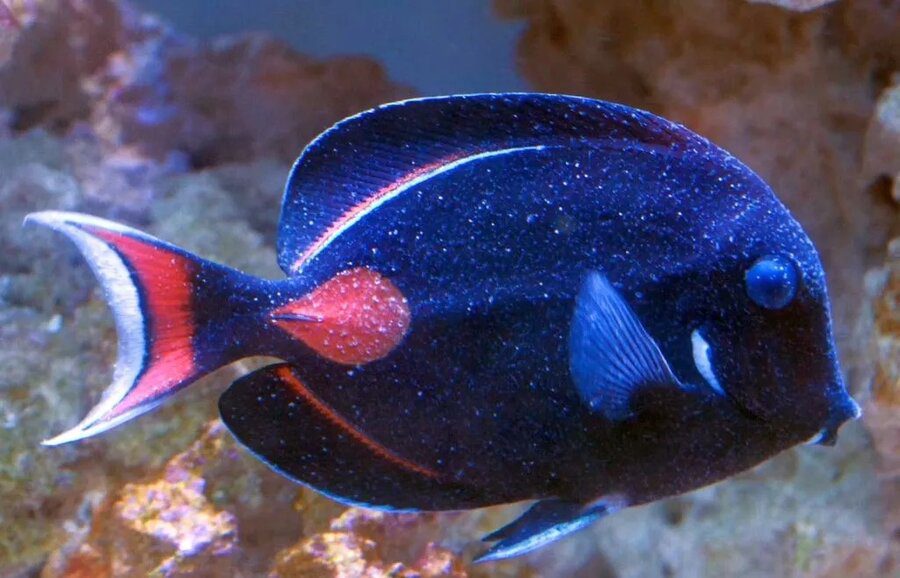Marine Velvet is the worst parasite, disease, or infection that you can get in your saltwater aquarium. Not only is it extremely infectious, it also is very difficult to get rid of, and very deadly. Most tanks that get velvet lose most, or all of their fish in a couple days.
How to identify Velvet
Velvet gets confused with ich sometimes, and has the appearance of white dots. The dots are pus or scabs on the fish. The rule of thumb is that if you can count the dots, it’s ich, if you can’t it’s velvet.

Velvet “dots” are usually extremely numerous, and take on the appearance of a fuzz, hence the name “Velvet”.

Another simple but brutal difference, is that most healthy fish can fight off ich with a little help, velvet is deadly. So if you have fish with those dots for a couple days, and no fish are dead, it’s not velvet.
What is Velvet
Marine Velvet is disease that affects saltwater fish and is known by several names, such as amyloodiniosis, marine oodinium disease, oodiniosis, and gold dust disease. The organism responsible for this disease is called Amyloodinium ocellatum, which is a type of dinoflagellate. Dinoflagellates are one-celled organisms that use whip-like structures called flagella to move, and this particular species is highly adapted to parasitism. While there are many free-living dinoflagellates in aquatic environments, Amyloodinium ocellatum is one of the few species that can cause disease in fish.
Treatment
Treatment options are pretty limited. Velvet is so deadly and so fast working, that whatever treatment you do choose has to be instituted immediately. From the time the first fish shows signs of ich, until things are too late, can be as short as a day.
One of the keys, is to have a treatment procedure in place. The good news is that all the treatments that work on velvet, also work on ich. That means you can cover 2 of the most common, and deadliest diseases with the same protocol. This also means, that when you do see the white dots, you can leap into action.
The options are really; copper, Chloroquine Phosphate, Prazipro, formalin, malachite green, hydrogen peroxide, freshwater dips, and medicated foods. Most are not reef safe, a few are, and some work better in different combos than others. We will go over each of them.
A quick note, there are ich/marine velvet solutions sold in a bottle. None of them work, and at best they have some of the ingredients of the options above, but usually they are snake oil. The reason being, if a company had a true “solution”, every single local fish store know it, every youtube video would mention it, every blog would tout it… and arguably it would double our hobby almost overnight. So unfortunately, this doesn’t exist right now.
Reef Tank
Reef tanks are complicated, as always. The main reason is that coral and inverts have a lot in common with the disease we are trying to kill, meaning it affects them too. In the case of velvet, you are 1000x better moving the fish into a quarantine tank and medicating them as described in the fish only section. Unfortunately that is often not possible. Big, established tank are usually very difficult to get fish out of. So here is the best options for a reef tank.
As a side note, using Chloroquine Phosphate to get rid of this disease is the gold standard. It is not reef safe, but it does dissolve out of the water as the biofilter flushes it out. Meaning if you can remove the coral temporarily, you can use Chloroquine Phosphate and then move the coral back when the treatment is over. It also completely kills the parasite meaning no need to keep your tank empty for 6 weeks to eradicate the ich/velvet.
So the main option is shock and awe… you have to do everything that you can, at the same time, in order to have even a chance of the fish making it through. Hydrogen peroxide dosing, feeding medicated food, reducing stress in the fish, prazipro, freshwater dips, hyper oxygenation of saltwater, biological help, and a UV system.
Humblefish has an article about using hydrogen peroxide dosing to help with ich and marine velvet. It is reef safe but it is experimental.
https://humble.fish/community/index.php?threads/peroxide-h2o2-dosing-for-parasites-in-reef-tank.725/
Basically the exact reason is not known, but in experiments it seems to work really well. One of the reasons fish die from this disease is by suffocation, the extra oxygen molecule in H202, pops off and becomes an extra 02 molecule, meaning more oxygen in the water. Some inverts, like harlequin shrimp, are damaged by hyperoxygenated saltwater, it seems like that also applies to velvet and ich. The protocol is on the humblefish website, so we will leave that link above. I suggest you bookmark it, and have hydrogen peroxide on hand.
Freshwater dips, or hydrogen peroxide dips, also can help the fish. If you can catch them without stressing them out, dips help quite a bit. Make sure the temperature is the same as your tank, and take them out if they have any issues breathing or panic. There are other dips that exist, but they are stressful on the fish, when your fish already has the outbreak, it is too late for those.
Medicated food can help. Use a high quality food like lrs reef frenzy or some other good food. Soak it in vitamins like selcon or a multivitamin. Anedocally liquid garlic extract and ginger also seems to help, it doesnt hurt. Lastly you want to add metroplex, and focus to the food in order to help the fish internally. None of this food or medicine is a “fix”, but it helps give the fish a bit more time to fend off the parasite.
Reduce stress in the fish. Lower the lights, overfeed, keep your water quality high, and minimize times catching the fish or scaring them by messing with the tank. Even going as far as putting cardboard over the sides can help, or adding clean pieces of angle pvc in order to give them extra places to hide.
Prazipro has the active ingredient praziquantel, which is basically an anti worm medicine. It has been shown to have a positive effect on helping with marine velvet and ich. You dose it as instructed on the label. It’s one of the few actual drugs that can be used in a reef tank. It’s not completely safe and any worm creatures will be damaged, such as bristle worms, or feather dusters.
These last two you should already have, and is a bit difficult to add quickly. Cleaner shrimp have been shown to clean off the parasites that cause ich and marine velvet. They are not susceptible to it, so it is a net loss. It’s about load on your fish, so the less parasites that can impact your fish the better. Cleaner wrasses on the other hand, will eat the parasites, but in the process catch them themselves. Also UV’s are a must. UV’s that are the correct size for your tank and tuned properly (flow rate matches manufacturers recommendations), can kill a huge amount of the parasites in their most vulnerable free floating stages.
Fish Only Tank
Chloroquine Phosphate is a miracle drug for reef tanks. It cures ich and marine velvet extremely effectively and consistently. It is less stressful thank copper on fish, it works faster (you have to ramp up copper to a therapeutic dose), it doesn’t linger in the tank after being used and works faster. The best part is that you don’t need to go fallow afterwards, it kills all the parasites.
Chloroquine Phosphate is a prescription medication. You need to either get it from an online fish medicine provider, from a vetrenarian or a very well stocked local fish store *cough Artistic Oceans cough*. It’s a medicine you should always have on hand for a rainy day, it is light and humidity sensitive so store it in a dark, dry spot.
Going back to humblfish, this is the dosing protocol
https://humble.fish/community/index.php?threads/chloroquine-phosphate.16/
Follow that protocol and you will give your fish the best chance of success of any other treatment.
Besides Chloroquine Phosphate, you should hit this devil of a disease with everything that is in your arsenal. Read through the reef tank section, do all of that. The only thing that is different is that you can also use malachite green.
Malachite green is an organic chloride salt that is the monochloride salt of malachite green. It is used as a green dye actually but it has anti fungal properties that also attach marine velvet.
Medicine List
This is the list, to save you time, of medicines to have in your cupboard to quickly react to marine velvet. At Artistic Oceans we do stock all these items, besides the garlic and hydrogen peroxide since they are not specialty items. But even saying that, we highly suggest you just have them on hand at home, speed is the biggest weapon you have against marine velvet.
Chloroquine Phosphate
Malachite green
Prazipro
Hydrogen Peroxide
Metroplex and Focus
Liquid Garlic Extract
Prevention
You don’t just have to “deal” with it if you get marine velvet. You can be proactive and make it very unlikely that you get it in the first place. There are a few steps, some are easier than others, to take.
First step, quarantine. Yes, it’s a pain in the butt, we get it. You want to see your fish in your tank, you don’t want the hassle. But this is the number one way. Quarantining fish in a cheap 20 gallon tank, can save you heartache. Just do it.
Next, sourcing fish. Best way is to get one from a quality local fish store. Ask them, do they use copper? Do they use hypo salinity in their tanks? Do the fish look healthy and fat? Do they let you see the fish eat first? Do the reviews online shop a history of positive reviews from happy customers?
Buying from people breaking down their tanks, from local backyard breeders or importers, sketchy fish stores, or online stores and wholesale distributors increase your risk of disease. You might be fine… but you might not. If you do source your fish from these places, you MUST quarantine, make yourself do it.
UV systems are another thing that should be mandatory in the saltwater hobby. It fixes tons of issues in your tank from appearance issues with algae, to diseases, bacterial infections, there are dozens of reasons to get one with the only negative being it costs money. When you get a UV system make sure you get one sized for your tank, and have the flow as the manufacturer recommends. UV flow matters, if its too slow it kills everything but doesn’t turn the water over enough to get everything. If the flow is too high, it doesn’t kill the baddies going through the UV.
Biological help. This means cleaner shrimp. We suggest a pair, more will just kill each other. They are one of the only animals that will fit in a home aquarium. Again, it wont stop anything but it can reduce the quantity of parasites attacking your fish giving them more of a chance. quality local fish store can also prevent many issues. UV, stress, food, cleaner shrimp, quarantine new fish
Most issues with the tank happen slowly, you can get advice and react. Marine velvet is not that thing. A bit of planning a prevention can help you avoid a serious heartbreak.




